For decades, home cooks have relied on french onion soup mix as a secret weapon for creating consistently delicious meatloaf. This simple ingredient blend transforms basic ground meat into a savory, moist centerpiece for dinner. The magic happens through the dehydrated onions, beef bouillon, and seasonings that infuse the meat with rich umami flavor while helping retain moisture during baking.
Why French Onion Soup Mix Works Perfectly in Meatloaf
French onion soup mix serves three critical functions in meatloaf recipes. First, the dehydrated onions reconstitute during cooking, adding sweet onion flavor without raw onion texture. Second, the beef bouillon and seasonings in the mix create a savory depth that plain salt and pepper can't match. Third, the cornstarch and flour in the mix help bind ingredients while retaining moisture—preventing the common problem of dry, crumbly meatloaf.
Professional chefs often recreate this blend from scratch, but the convenience of the packaged mix makes it perfect for weeknight cooking. The consistent flavor profile and foolproof results explain why this easy meatloaf recipe with french onion soup mix has remained popular for generations.
Essential Ingredients Breakdown
Understanding each component ensures perfect results every time. While some meatloaf with french onion soup mix and ketchup variations exist, this classic version delivers reliable flavor.
| Ingredient | Amount | Key Purpose |
|---|---|---|
| Ground beef (80% lean) | 1.5 lbs | Provides rich flavor and proper fat content for moisture |
| French onion soup mix | 1 packet (1 oz) | Flavor base, moisture retention, and binding |
| Breadcrumbs | 3/4 cup | Absorbs juices while maintaining structure |
| Milk | 1/2 cup | Hydrates breadcrumbs for better texture |
| Egg | 1 large | Binds ingredients without making dense |
| Ketchup | 1/2 cup | Creates sweet-tangy glaze during baking |
Step-by-Step Preparation Guide
Follow these precise steps for the best meatloaf recipe with french onion soup mix that stays moist and slices cleanly:
- Preheat oven to 350°F and line baking sheet with parchment paper
- Soak breadcrumbs in milk for 5 minutes until fully absorbed
- Mix ingredients gently in large bowl: ground beef, soaked breadcrumbs, soup mix, egg, and optional Worcestershire sauce
- Shape loaf into 9x5 inch oval on baking sheet (avoid over-packing)
- Prepare glaze by mixing 1/2 cup ketchup with 2 tablespoons brown sugar
- Spread glaze evenly over loaf 15 minutes before finishing baking
- Bake 60-75 minutes until internal temperature reaches 160°F
- Rest 10 minutes before slicing to retain juices
Avoiding Common Meatloaf Mistakes
Even experienced cooks encounter issues with french onion soup mix meatloaf ingredients. Prevent these frequent problems:
- Dry texture: Using leaner than 80% ground beef or overmixing causes dryness. Handle meat gently and use proper fat content.
- Crumbly slices: Slicing too soon prevents proper setting. Always rest meatloaf 10 minutes after baking.
- Soggy bottom: Baking directly in loaf pan traps moisture. Use a parchment-lined baking sheet for even cooking.
- Overpowering onion flavor: Some brands contain excessive onion powder. Stick with Lipton or equivalent for balanced flavor.
Serving and Storage Recommendations
This traditional meatloaf recipe with onion soup mix pairs perfectly with mashed potatoes and green beans. For meal prep, slice leftovers into portions and store in airtight containers. Properly stored meatloaf maintains quality for:
- Refrigerator: 3-4 days at 40°F or below
- Freezer: 3-4 months when wrapped tightly
Reheat slices covered with damp paper towel in microwave for 1-2 minutes, or warm in 325°F oven for 15 minutes. The ketchup glaze prevents drying during reheating.
Variation Options for Dietary Needs
Adapt this versatile classic meatloaf using french onion soup mix for different dietary requirements:
- Gluten-free: Substitute gluten-free breadcrumbs and verify soup mix is GF (some contain wheat)
- Lower sodium: Use low-sodium soup mix and reduce added salt
- Vegetarian option: Replace beef with 2 cups cooked lentils and 1 cup walnuts
- Spicy version: Add 1/4 teaspoon cayenne to the meat mixture
Frequently Asked Questions
Can I use French onion dip instead of soup mix in meatloaf?
No, French onion dip contains significantly more fat and moisture than dehydrated soup mix. Using dip would make the meatloaf too wet and prevent proper binding. Stick with the dry soup mix for best results.
Why does my meatloaf fall apart when I slice it?
Meatloaf typically falls apart when sliced too soon after baking. Always let it rest for 10 minutes to allow proteins to set. Overmixing the meat or using insufficient binder (egg and breadcrumbs) also causes structural issues.
How do I prevent meatloaf from sticking to the pan?
Line your baking sheet with parchment paper instead of using a loaf pan. This creates a non-stick surface and allows fat to drain away, preventing soggy bottoms. If using a loaf pan, grease it thoroughly with cooking spray first.
Can I make this meatloaf ahead of time?
Yes, prepare the meat mixture and shape the loaf up to 24 hours in advance. Store covered in the refrigerator, then add the glaze and bake when ready. This actually improves flavor as the seasonings have more time to penetrate the meat.
What temperature should meatloaf reach when done?
Meatloaf is fully cooked when it reaches 160°F (71°C) at the center. Use an instant-read thermometer inserted into the thickest part. The temperature will rise 5-10 degrees during resting, so remove from oven at 155°F for perfect results.











 浙公网安备
33010002000092号
浙公网安备
33010002000092号 浙B2-20120091-4
浙B2-20120091-4